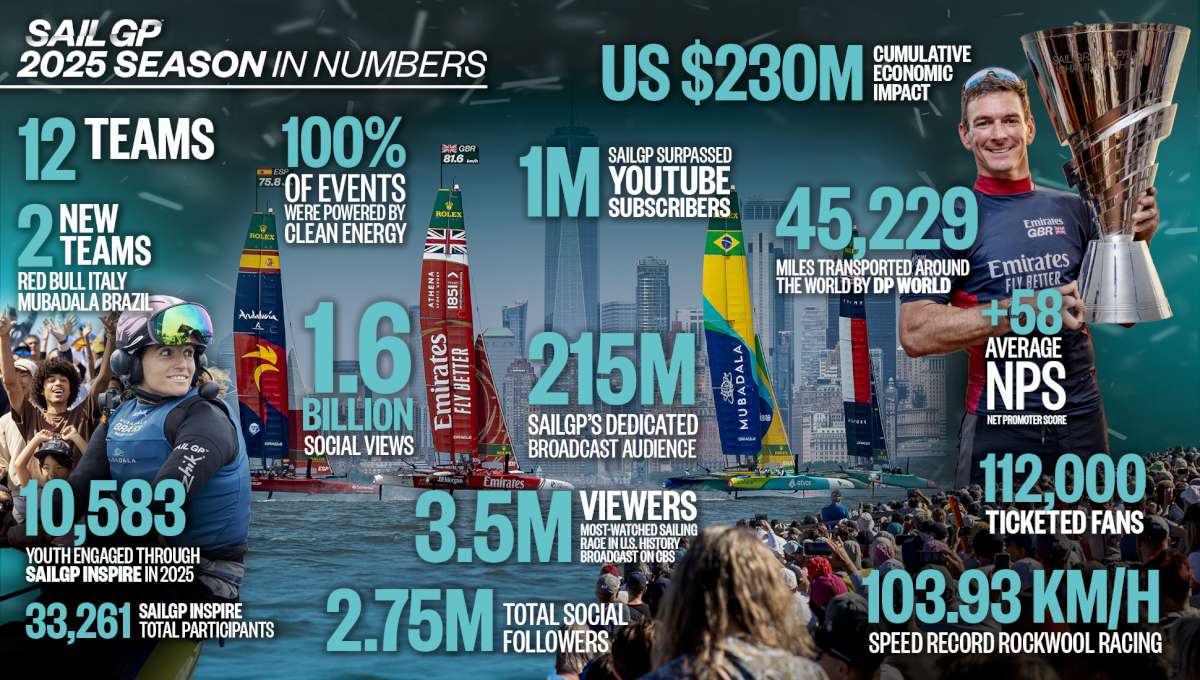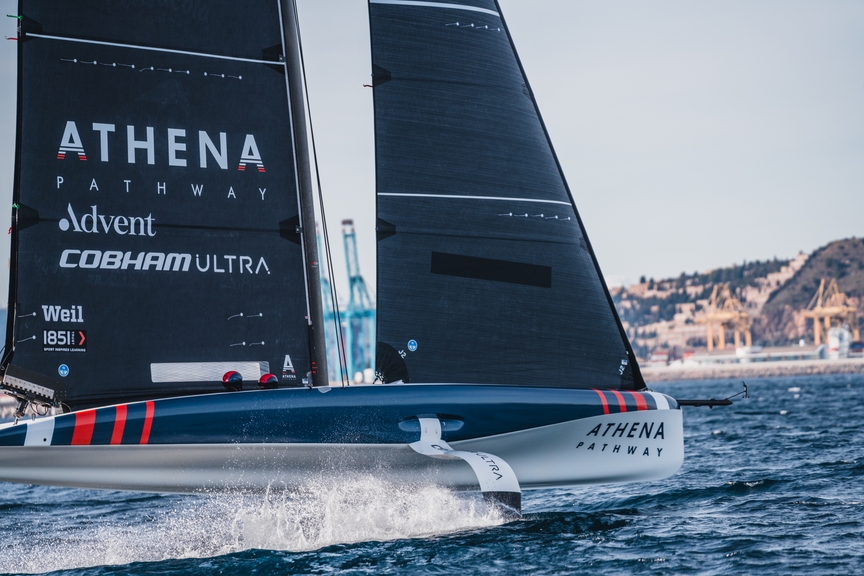SPEED & SMARTS
ANALYSIS
IT DREW the first penalty ever given by an umpire in America's Cup history. It was the
deciding moment in the seventh and final race of the 2007 America's Cup.
“It” was a port-starboard situation between Alinghi and Emirates
Team New Zealand near the port layline to the second windward mark.
This incident makes an interesting case study for many reasons, but it is
especially appropriate in this issue because the decision hinged on the
umpires' application of Rule 16. Here is a quick recap of what happened, plus
an in-depth look at how Rule 16 applies during this situation.
A failed attempt to duck As the boats approached the port layline, both were
sailing closehauled on starboard tack with NZ ahead and to leeward of Alinghi.
NZ was about a boatlength ahead in the race, but not far enough to allow
her to tack and cross in front of Alinghi (who would have right of way
on. starboard tack) NZ decided their best tactic would be to sail past
the layline, tack and bear off behind Alinghi. They knew that ducking Alinghi
on a reach near the layline would put them in a fairly strong position, both
tactically and rules-wise.
But Alinghi had practiced this manoeuvre many times in the previous
months and decided to defend their position aggressively. As soon as NZ
started to tack, Alinghi bore off to a reaching course that would
intersect NZ. They did this perfectly so NZ could still not cross
ahead of them and would have a hard time ducking behind them. Then Alinghi
held their course for roughly two to three boatlengths (8-10 seconds).
The boats came within one length of each other and then Alinghi headed
up, apparently to avoid NZ. Both boats flew protest flags. Alinghi
claimed NZ broke Rule 10, and NZ thought Alinghi's course
change broke Rule 16.
Rule 10 or Rule 16?
The umpires had to make a quick (and momentous) decision. Penalise Alinghi?
Penalise NZ? Or display a green flag (meaning no penalty)?
First of all, it seemed that NZ broke Rule 10 (opposite tacks). She
was on port tack and didn't appear to keep clear of Alinghi who was on
starboard tack. In other words, NZ did not allow Alinghi to
“sail her course with no need to take avoiding action.” That was a
reason to penalise New
Zealand.
However, before making their decision, the umpires had to look at the rest
of the incident. When Alinghi changed her course and bore off toward NZ,
did she give NZ room to keep clear? If not, then Alinghi broke
Rule 16. In that case she would be penalised and NZ would beexonerated
(because when Alinghi broke Rule 16 she compelled NZ to break
Rule 10).
The umpires also had other issues to consider before making a final call.
First, Rule 16.2 did not apply because the match racing appendix deletes it.
Therefore, Alinghi did not have the extra limit on course changes that
usually applies to a starboard-tacker when a port-tacker is passing behind her.
Second, there is an umpire call from the match racing callbook that applies
here. It says, basically, that when P is ducking S, S may not sail a downwind
course. In other words, Alinghi could not turn below a true wind angle
of 90' in this situation. If she did, she was not considered to be giving NZ
room to keep clear.
After careful thought and discussion, the umpires decided to penalise NZ.
They felt that Alinghi did not sail below a beam reach and that she held
her course long enough to give NZ room to keep clear. Since NZ
did not keep clear, she got the penalty.
When New Zealand
tacked above the layline and bore off on port tack to go behind Alinghi,
she was entitled to the protection of Rule 16.1 but not 16.2 (because that rule
is deleted for match racing). However, Rule 16.1 protects the give-way boat
only as long as she is doing everything possible to keep clear of the
right-of-way boat. In this case, the umpires felt that New Zealand
did not do all she could to get out of Alinghi's way; therefore they
penalised her. (Chris Cameron/ETNZ)
1. NZ and Alinghi are on starboard tack near the top of the
second beat. NZ is ahead but not quite far enough to tack and cross
ahead of Alinghi. NZ sails several boatlengths past the port-tack
layline.
2. NZ begins to tack; Alinghi starts to bear off.
3. NZ completes her tack and keeps bearing off. Alinghi bears off
to a close reach.
4. NZ continues to bear off; Alinghi almost gets to a beam reach
and stops turning.
5. In an effort to keep clear and pass astern of Alinghi, NZ
bears off to a broad reach; Alinghi appears to hold her course on a beam
reach for approximately 8-10 seconds (2-3 boatlengths).
6. Between 5 and 6 the boats become closer than one length apart and Alinghi
heads up sharply. Both boats display Y flags to signal protest.
7. Alinghi tacks above the layline and ends up to windward of NZ,
who is also on port tack but just below the layline. The umpires display NZ's
flag – penalty NZ!
Notes about the application of Rule 16
1. Rule 16.2 is deleted by the match racing rules (Appendix C2.5). Therefore,
when NZ bears off to pass astern of Alinghi, there is no
additional limitation on Alinghi's course changes besides Rule 16. 1. In
other words, as long as Alinghi gives NZ room to keep clear, it's
0K for Alinghi to change her course in a way that causes NZ to
react immediately.
2. Though 16.2 doesn't apply here, there is an umpire “call” (an
authoritative interpretation like an appeal) that limits what a starboard
tacker can do in match racing. Call Ump 20 (and Call AC-19) applies when P
bears off to pass astern of S. It says that if S bears away to a “downwind
course” (defined as a true wind angle greater than 90deg) and causes P to
change course to keep clear, S breaks Rule 16.1 because she fails to give P
room to maneuver in a seamanlike way. Therefore, in this situation Alinghi
had to be careful not to sail below a beam reach (i.e. lower than 90deg to the
wind).
3. Throughout this incident, Rule 16.1 applied to course changes made by the
right-of-way boat. NZ held the right of way in positions 1 and 2 until
she passed head to wind. She regained the right of way when Alinghi
passed head to wind after position 6. Alinghi had right of way as the
boats converged so her course changes were limited by Rule 16. Therefore, when
she changed her course she had to give NZ room to keep clear.
4. The umpires penalised NZ under Rule 10 (port-starboard) because Alinghi
had a need to take avoiding action. They felt that Alinghi held her
course for a sufficient time and that NZ could (and should) have done
more to keep clear.
This article is extracted from Speed & Smarts, a newsletter published
by David Dellenbaugh filled with how-to information for racing sailors. Dellenbaugh,
tactician aboard the 1992 America's Cup winner and an adviser to the German
United Internet team for the 2007 AC, besides being a top sailor is a skilled
communicator on tactics, rules and boathandling.
























